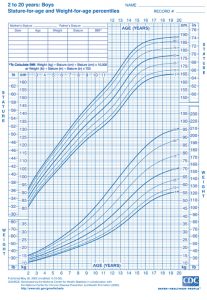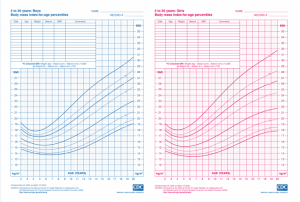Childhood Obesity and Overweight

Childhood obesity: is my child too big?
It’s a touchy subject, but unfortunately childhood obesity is increasing at an astronomical rate. According to the World Health Organisation (WHO), global childhood overweight and obesity rates have increased worldwide from 32 million in 1990 to 42 million in 2013. In the USA, obesity affects around 12.7 million children and adolescents aged 2-19 years; in the UK, one third of children aged 10-11 years, and nearly one fifth of children aged 4-5 years are either overweight or obese. And it isn’t just a disease of the West; in Singapore, 12% of schoolchildren are obese.
What is Childhood Obesity and Overweight?
We use body mass index (BMI) to define overweight and obesity. A child with a BMI of greater than the 85th percentile on the BMI for age charts is regarded as overweight, and a child with a BMI greater than the 95th percentile is obese. We calculate BMI as:
Weight in kilograms ➗(Height in metres x Height in Metres)
For example, a five year old boy has a weight of 28kg and a height of 115cm (1.15m). His weight is above the 97th percentile and his height is on the 90th percentile. Is he just a big boy, or is he at risk of childhood obesity?

CDC Boy’s height and weight charts age 2-20 years
https://www.cdc.gov/growthcharts/data/set2clinical/cj41c071.PDF
BMI Calculation: 28 ➗ (1.15 x 1.15) = 21
We take the calculated BMI and then plot it on the BMI for age charts. A BMI of 21 in a 5 year old boy is greater than the 95th percentile on the BMI for age charts, and so this child is actually obese.

CDC child BMI charts 2-20 years
https://www.cdc.gov/growthcharts/data/set1clinical/cj41l023.PDF
Why Does It Matter?
Childhood obesity is associated with significant short and long term health problems, ranging from the misery of being teased and bullied in school, and all the psychological trauma that it brings, to the medical complications of high blood pressure, high cholesterol, increased risk of heart disease and diabetes, and even certain types of cancer.
Studies show that approximately 70% of obese children go on to become obese adults. A child who is obese by the age of 4 years is likely to struggle with weight related issues throughout his adult life.
What Causes Overweight and Obesity in Children?
There are three main factors contributing to the 21st century obesity epidemic:
1. Poor dietary choices: there is increased availability of high fat, high energy “fast foods”. Many of these foods are cheaper and easier to obtain (as well as being more appealing to young children and adolescents) than so-called “healthy options”. In fact, childhood obesity rates are increasing in many developing countries in urban areas where fast food options are often the cheapest food available.
2. LIfestyle choices: less children are playing outdoors today than a few decades ago. Previously, it was common to come home from school and then play soccer in the back garden, or a game of hide and seek in the street. Multiple studies as far back as 25 years ago have highlighted the relationship between screen time and childhood obesity.

Child playing computer games
Interestingly, TV appears to have the strongest link with obesity; studies cite passive snacking whilst watching TV and the effects of junk food and snack advertising (which then impact food choices), as well as the lack of active exercise.
3. Portion size: I see obesity increasing even in families where the parents are well educated and are making so-called “healthy” choices regarding the types of food they give their children. Unfortunately, even healthy food will result in obesity if given in large quantities. Fresh fruit is, of course, preferable as a snack or dessert to processed, high fat- high sugar desserts, but even fruit contains sugar, and if given in large quantities unchecked several times a day will still result in an energy imbalance (energy in is greater than energy out). Similarly, of course whole grain carbohydrates are preferable to highly processed carbohydrates, but a child should still be restricted on the amount he takes.
What Can I Do?
1. Healthy food choices: reduce high energy, high fat foods to a minimum. Allow fast food “treats” once every few months, rather than once or twice a week. Encourage other treats: for example, in our house, a favourite alternative to eating out at a fast food restaurant is sushi (my four year old inhales salmon sashimi!). Replace processed carbohydrates with their healthier alternatives: wholegrain pasta and bread, and brown rice, rather than the “white” processed versions.
Adopt the “healthy plate” approach:

My Healthy Plate http://www.vch.ca/media/VCH-healthy-plate-header.jpg
2. Limit screen time and increase outdoors exercise. Aim for one hour of outdoors exercise per day, which raises the heart rate and leaves your child slightly sweaty- sweaty is good! This will also have the added benefit of increasing his body’s vitamin D production and reducing his risk of myopia (short-sightedness). Find an activity your child enjoys doing, or even find a hobby you can both enjoy together, such a cycling, swimming or running.

Exercising as a family is fun- and good for you!
Previous recommendations on screen time were to aim for no more than 2 hours per day; however, more recent studies suggest that two hours may be too much, and we should aim for significantly less than this.
3. Portion size: Forget your personal hang ups about melamine Hello Kitty and Transformers plates, and go buy them for your child. The use of these plates helps in controlling portion size much more than trying to put a child-size portion on an adult-size plate.
The other major pitfall in controlling your child’s calorie intake is second helpings, and the belief that as long as you are serving “healthy choices” your child can have unlimited servings of them. Stick to just one appropriately sized portion. If you want to reward your child, don’t use food as a reward.
What problems have you come across in preventing obesity and overweight in your children? Have you found any other strategies that have worked for you? Leave you comments below.
If you enjoyed reading this article, do subscribe so that you won’t miss any of the upcoming articles. Enter your email address in the top right -hand corner and hit the Subscribe button.

4 Comments
One of the biggest problems we experienced was school dinners and teachers/dinner ladies telling the children to clear their plates. Before he went to school our son was healthily skinny, now – 6 years later – he has no internal fullness cue and therefore no ‘off switch.’ And we are wrestling with his weight.
Yes- unfortunately, praising children for completing their meals, especially with children who are naturally “pleasers”, can have a negative effect. Try getting him to drink a glass of water before starting his meal, and remind him to eat more slowly, so that his body’s natural satiety, or “fullness”, feedback mechanism has a chance to function.
A topic very much on my radar at the moment so glad I came across this article!
We are trying to adopt a healthier lifestyle in this house – food, exercise and well-being. I think the exercise is a major factor at the moment as ‘J’ gave up football last summer and we haven’t found something that he enjoys doing to replace it yet. He loves to cycle but difficult to fit that in midweek. Looking forward to the lighter evenings so we can get out and do a little more.
Going to cut back on the sugar intake and portion sizes and see what difference we can make together with an increase in exercise. Great article! Thanks x
You are more than welcome- all the best adopting a healthy lifestyle, Natalie